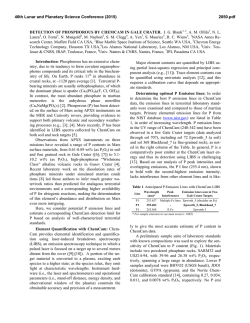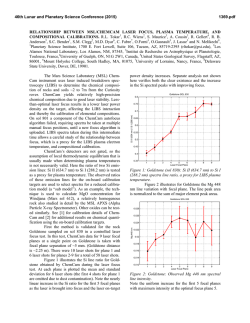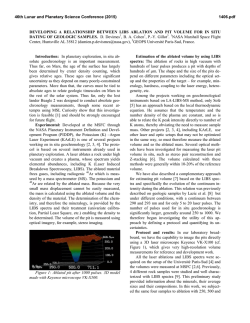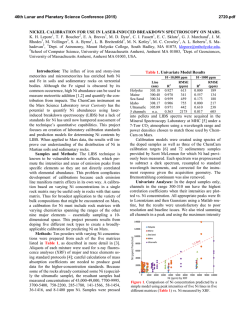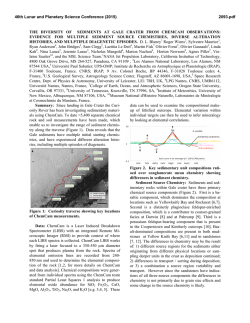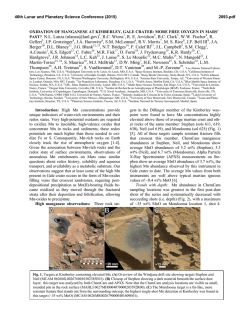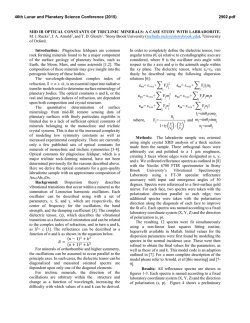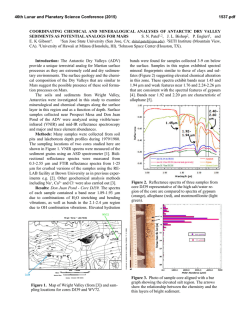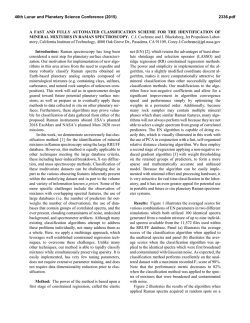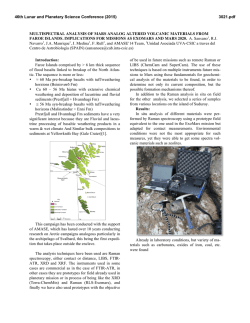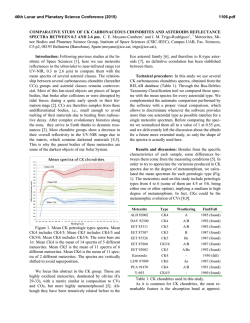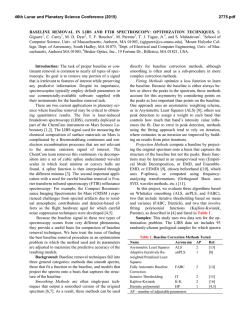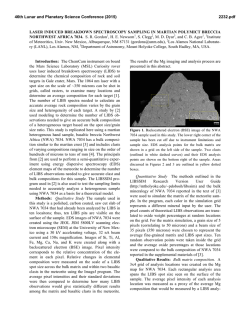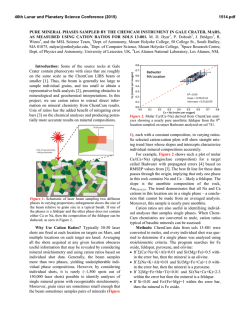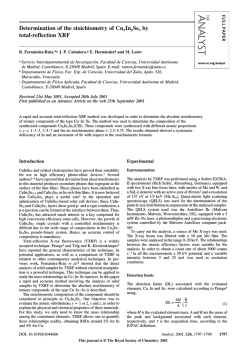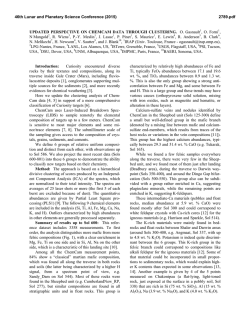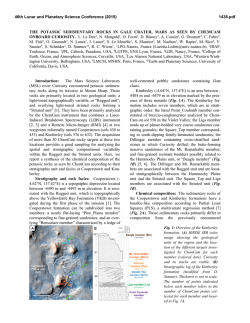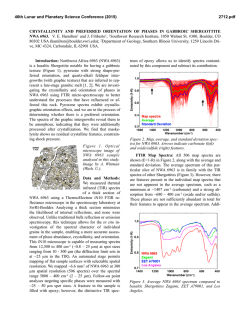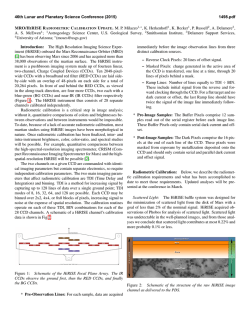
CR, NI, MN, CO, ZN, AND S STANDARDS FOR USE IN LASER
46th Lunar and Planetary Science Conference (2015) 2338.pdf CR, NI, MN, CO, ZN, AND S STANDARDS FOR USE IN LASER-INDUCED BREAKDOWN SPECTROSCOPY ON MARS. E. A. Breves1, L. B. Breitenfeld1, M. N. Ketley1, A. L. Roberts2, M. D. Dyar1, C. I. Fassett1, E. C. Sklute1, K. H. Lepore1, G. J. Marchand1, J. M. Rhodes2, M. Vollinger2, S. A. Byrne1, M. C. Crowley1, T. F. Boucher3, S. Mahadevan3, 1Dept. of Astronomy, Mount Holyoke College, South Hadley, MA 01075, [email protected], 2Dept. of Geosciences, University of Massachusetts Amherst, Amherst MA 01003, 3 School of Computer Science, University of Massachusetts Amherst, Amherst MA 01003, USA. Introduction: Laser-induced breakdown spectroscopy (LIBS) is being used by the ChemCam instrument on the Mars Science Laboratory rover Curiosity to obtain UV, VIS, and VNIR atomic emission spectra of surface rocks and soils [1,2]. LIBS quantitative analysis is complicated by chemical matrix effects related to abundances of neutral and ionized species in the plasma, collisional interactions within plasma, laser-to-sample coupling efficiency, and self-absorption [3]. Atmospheric composition and pressure also influence plasma intensity. Chemical matrix effects influence the ratio of intensity or area of an emission line to the abundance of the element producing that line. To overcome these effects, multivariate techniques such as partial least-squares regression (PLS) have been utilized by the ChemCam team to predict major element compositions (>1 wt.% oxide) of rocks [4]. Because PLS utilizes all available explanatory variables and eliminates multicollinearity, it generally performs better than univariate methods for prediction of major elements [1,2]. However, peaks arising from emissions from trace elements are often dwarfed by peaks of higher intensities from major elements and may have low transition probabilities [5]. This can result in multivariate predictions that use compatible major elements to predict minor ones, e.g. use of K1+ lines to predict Rb1+. To better characterize and understamd matrix effects in geological samples, this project focuses on creation of standards doped with varying amounts of Cr, Ni, Mn, Co, Zn, and S. Integration of these LIBS standard spectra into existing spectral libraries, when combined with multivariate analyses, should produce improvements in accuracy of predicting these elements. Background: Issues with geochemical camouflage arise because minor and trace element cations can substitute into mineral sites occupied by major elements, as long as their radii differ by less than ~15% and they have the same charge. In such cases, multivariate techniques will tend to use stronger major element lines to predict trace element concentrations, but concentrations thus predicted are only as good as the correlation between the two elements that is seen in terrestrial samples. This problem is magnified by the fact that smaller emission lines from trace elements are often dwarfed by intense lines from far more abundant major elements. Some workers [6,7] have used univariate analyses and special techniques that focus on spectral regions where minor and trace element emissions occur to obtain accurate predictions of minor and trace elements using LIBS. Table 1. Bulk Rocks Used as Matrices for Doping Name Provenance Lower Jurassic basalt from Newark SuperHolyoke group, Massachusetts Columbia River continental flood basalt colIdaho lected in Moscow, Idaho by Mickey Gutner Vinalhaven intrusive complex, Vinalhaven, Maine Maine Sea Sand Washed SiO2 sea sand from Fisher Scientific 50:50 by weight mixture of diopside and Ultramafic Globe olivine from [8] Samples and Methods: This project used five matrics with very different bulk compositions (Table 1). Exactly 10 g of NiO, Cr2O3, MnO2, CoO, ZnO, and Fe2+SO4•7H2O were shatterboxed with 90 g of each powdered matrix, resulting in 25 samples, each ~10 wt.% dopant. Those mixtures were then diluted with additional aliquots of matrix to create mixtures of approximately 5, 1, 0.5, and 0.1 wt% and 500, 250, 100, Figure 1. (top) LIBS spectral region around the 422.6 nm Cr I peak showing increasing intensity with dopant amount. (bottom) Example of a calibration curve for the 396.91 nm peak in the Maine spectra shown above. 46th Lunar and Planetary Science Conference (2015) 50, and 10 ppm of dopant depending on the molecular weight of the dopant. Each mixture was shatterboxed for one minute to homogenize it and reduce the grain size <45 µm. Pellets were pressed from powders into 1.5 cm diameter aluminum cups for LIBS analyses. Aliquots of each mixture were also used for x-ray fluoresence analyses (XRF) in the laboratory at U Mass [9], where samples were analyzed for major and trace elements. Additional analyses will be undertaken using other tehcniques as needed, such a Leco for S. LIBS spectra were acquired from 30 shots on each of >5 locations on each pellet using a Mars-analog LIBS instrument in the Mineral Spectroscopy Laboratory at Mount Holyoke [10] under a 7-Torr CO2 atmosphere. Data were processed using software with steps analogous to those used for ChemCam data [10], including normalization to each of three wavelength regions corresponding to the three spectrometers. Figure 2. Comparison of spectra for each sample with normalized intensity plotted on the same scale for all five matrices. The composition of the rock matrix affects the normalized peak intensity profoundly. This effect complicates interpretation of trace and minor element lines. Results: Figure 1 shows a portion of the UV spectrum where a Cr I peak falls at 422.6 nm. The peaks increase in intensity with concentration, and the total area of these peaks produces a useful calibration curve for this granitic matrix. The ChemCam team has used such univariate calibration curves to effectively model major and trace element [6,7,11] concentrations for Mars samples. The success of these calibrations depends on the availability of well-resolved, unoverlapped peaks diagnostic for the elements of inter- 2338.pdf est that also have high transition probabilities. The elements in this study have the following ionization energies: 9.39 eV for Zn, 7.88 eV for Co, 7.64 eV for Ni, 7.43 for Mn, 6.77 eV for Cr, and 10.36 eV for S. The success of univariate calibrations is further dependent on having a close match between the matrix of the standards and that of the unknown(s) or a broad representation of different matrices in the training set. In some cases, univariate calibrations cannot overcome differences among matrics (e.g., Figure 2). More specifically, Figure 2 documents the variations in spectral intensity that occur between matrices. The figure shows normalized spectra but the unnormalized data also show interesting differences. The sea sand produces the lowest intensity spectra in both cases, perhaps due to poor coupling of the laser due to composition. The un-normalized ultramafic spectra has nearly double the raw intensity of the other four matrices, resulting in nearly the lowest normalized intensity, again likely due to good coupling. Typically, normalized data are used for calibration because they produce the lowest errors. Implications: Just as calibrations for major element quantification for ChemCam have used numerous stanards with varying bulk compositions, so too must trace element analyses be dependent on representation of a wide range of matrix types for calibrations. We are continuing to build a broad calibration database for analysis of minor and trace elements by LIBS, though the task is extremely time-consuming and costly. We plan to test proven calibration techniques such as use of peak areas and masked wavelength ranges [3,6] on our data set to improve prediction algorithms. Finally, use of multivariate models that focus on well-selected regions of the spectra where minor element emission peaks are present will be used to optimize predictions of minor and trace elements. The resultant calibration will be useful in interpreting chemistry of Martian rocks from extraterrestrial instruments such as ChemCam and Super Cam. Acknowledgments: This work was supported by NASA grants NNX09AL21G, NNX12AK84G, and NNX14AG56G from the MFR Program. References: [1] Wiens R. C. et al. (2012) Space Sci. Revs., doi:10.1007/s11214-012-9902-4 [2] Maurice S. et al. (2012) Space Sci. Revs., doi:10.1007/s11214-012-9912-2. [3] Clegg S. M. et al. (2009) Spectrochimica Acta Part B, 64, 79-88. [4] Wiens R. C. (2013) Spectrochim. Acta B, 82, 1-27. [5] Dyar M. D. et al. (2010) Spectrochim. Acta B, 66, 3956. [6] Ollila A. M. (2014) JGR, 119, 255-285. [7] Fabre C. (2014) Spectrochim. Acta B, 99, 34-51. [8] Byrne, S. (2015) this volume. [5] Rhodes J. M. (1988) JGR, 93, 4453-4466. [10] Dyar M. D. et al. (2015) this volume. [11] Lasue, J. et al. (2015) this meeting. [12] Lepore K. H. (2015) this meeting.
© Copyright 2025
